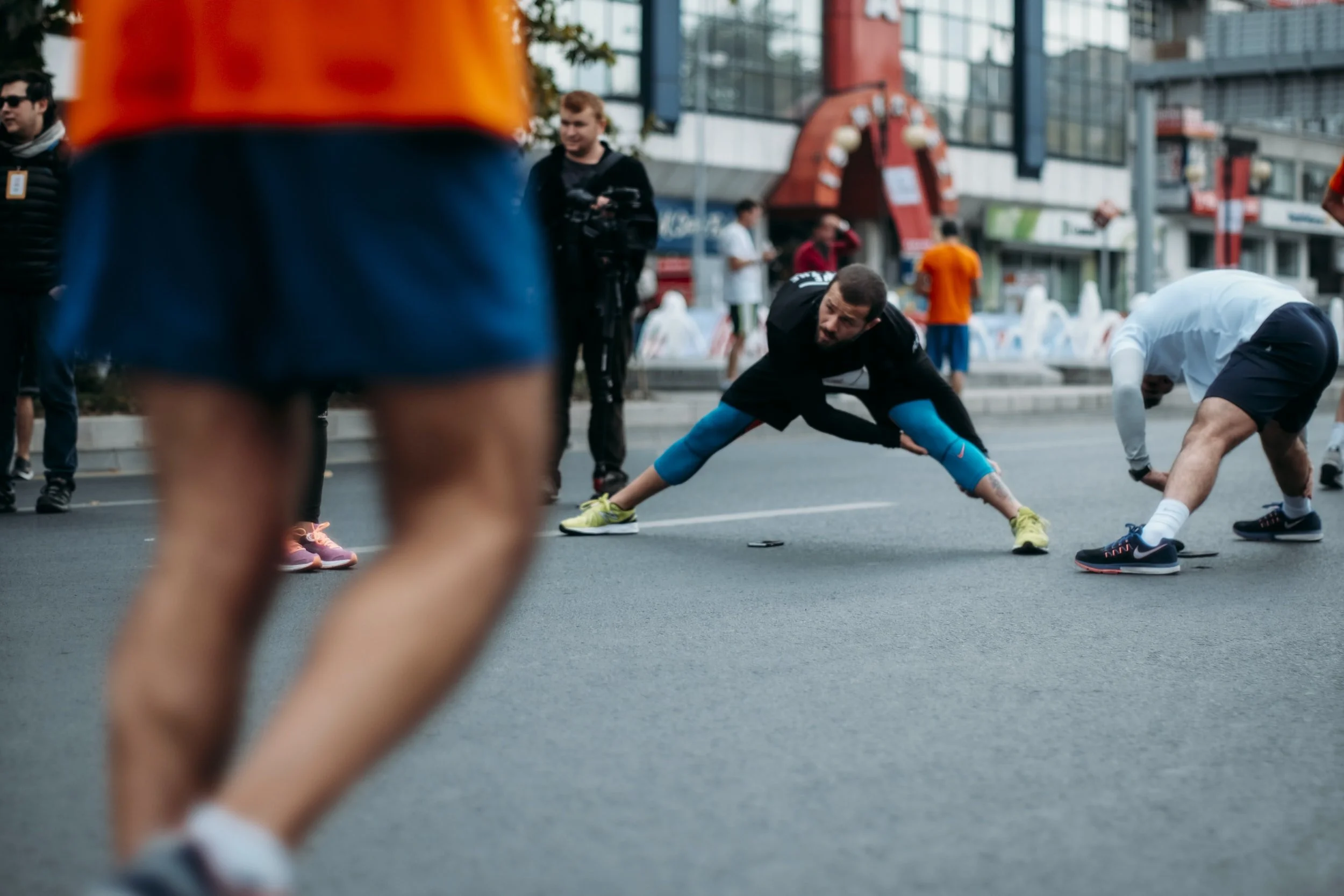Stretching before a race: Good or Bad?
Race season is almost here! As a running expert PT, I’ve heard almost all the pre-race routines in the book! The question that always seems to come up is, “should I stretch before a run?”
Runners all around Louisville are getting pumped for their races this spring. Whether it’s the Triple Crown, KDF mini-marathon, or full marathon, you’re bound to see some calf stretchers holding up a building or some quad stretchers doing they’re best flamingo impression.
The mentality is there at the start line, but is the body ready?
Let’s dig into the common debate among athletes about if they should stretch prior to an event.
Have you ever watched a pitcher warm up in a bullpen? Or a swimmer warm up before stepping onto the blocks? These are very different activities from running, however, preparing for any competition is very similar. Both of these athletes will perform movements or activities that mimic their sport. Take a look around and see what runners are doing… they’re doing the complete opposite.
Should you stretch before a race?
Several runners I see at the races are sitting on the ground stretching their adductors, quads, hamstrings, calves, or sitting in a butterfly position. I think to myself, “Noooooo. That’s not how you warm up to get ready for your race,” and there’s a reason for that!
Stretching your muscles is a way of “pulling-apart” the muscle fibers with their myofilaments, known as myosin and actin. These fibers are required to create a powerful muscular contraction. They work together as a “power stroke,” as the myosin head grabs onto a binding site of the actin and pulls it tight. If you stretch these out too much before an event, you will lose power and the “spring” in your step.
Let me geek out on PT facts for a minute… stay with me, this gets cool!
Sarcomere: the basic unit of a musculoskeletal system, which includes the Myosin and Actin myofilaments (proteins) that generates the power stroke creating muscular contractions.
When a muscle is being lengthened during stretching, it’s not just the actual muscle cells being elongated. 40% of the actual stretch is coming from the elongation of its fascia and other connective tissues that surround, encase and penetrate throughout the muscle. These connective tissues comprise 30% of the bulk of a muscle, involving nerves and blood vessels to nourish the muscles. Fascia is loaded with collagen and elastin molecules to allow movement and protects from injuries. With too much stretching, the fascial tissues lose their ability to recoil and the inherent elasticity of these connective tissues disintegrates and becomes less functional as a result. (Source: Gaiam.com/blogs)
Take it from Slinky
Stretching your tendons is a way of lengthening the spring like a long dachshund, Slinky from Toy Story.
“[A tendon’s] main function is to transmit forces from our muscles, acting somewhat like a spring to amplify our own muscle forces, and to absorb external forces on the body. Each tendon is composed of a combination of fibrous collagen and stretchy elastic connective fibers, ensuring that they are strong enough to help you launch into a jump, but soft enough to absorb the impact of the landing.” (Excerpted from source: sportstecclinic.com.au)
Should I stretch at all?
Okay, so you’re telling me to not stretch before my race or competition… should I stretch at all? When? And what should I do before the race instead?
Stretching is fantastic AFTER you have cooled down from a hard workout, race, or competition. It’s a great way to enhance your muscle recovery by flushing out the lactic acid and to keep it mobile but strong. Additionally, stretching reduces the effects of muscles “stiffening up” when your core temperature cools down quickly.
What to do before a race?
Below is great warm up routine to try!
Hip Mobility: Walking with hip circles and walking with knee to chest pull-ups.
Spring-load: Quick feet agility drills while staying on your toes to get your calves warm and achilles tendon springy!
Sport-specific: Runners-march with mini deadlifts and mini lunges, glutes activation, and upright posture resetting.
Now you’re ready!
Stretching for Flexibility vs Stretching for Mobility
I want to change your mindset of stretching for flexibility to the mindset of stretching for mobility. As we age, we will become less mobile and at some point we’ll complain of stiff and aching muscles when we wake up in the morning. Sound familiar? The last thing I want to see in my active community in Louisville is to not do their favorite activity outside because they lost mobility.
Dedicating as little as one day a week for 15 minutes to mobility exercises can greatly enhance your reachability and performance in your sport/activity.
To sum up: STRETCH! Just don’t do it before you race.
There you have it. Next time the question, “to stretch, or not to stretch,” enters your mind, I hope you’ll think back to this blog and be strategic as to when and how you stretch.
Still have questions? Reach out anytime, I’d love to chat all things stretching, mobility, and running injuries! Get in touch: HERE



